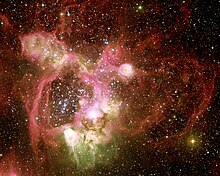astro.wikisort.org - Nebula
N44 is an emission nebula with superbubble structure located in the Large Magellanic Cloud, a satellite galaxy of the Milky Way in the constellation Dorado.[3][4][5] Originally catalogued in Karl Henize's "Catalogue of H-alpha emission stars and nebulae in the Magellanic Clouds" of 1956, it is approximately 1,000 light-years wide and 160,000-170,000 light-years distant.[6][7][1] N44 has a smaller bubble structure inside known as N44F. The superbubble structure of N44 itself is shaped by the radiation pressure of a 40-star group located near its center; the stars are blue-white, very luminous, and incredibly powerful.[6][1] N44F has been shaped in a similar manner; it has a hot, massive central star with an unusually powerful stellar wind that moves at 7 million kilometers per hour. This is because it loses material at 100 million times the rate of the Sun, or approximately 1,000,000,000,000,000 tons per year. However, varying density in the N44 nebula has caused the formation of several dust pillars that may conceal star formation.[6] This variable density is likely caused by previous supernovae in the vicinity of N44; many of the stars that have shaped it will eventually also end as supernovae. The past effects of supernovae are also confirmed by the fact that N44 emits x-rays.[4][8]
| Emission nebula | |
|---|---|
| superbubble | |
 The central region of N44 | |
| Observation data: J2000.0 epoch | |
| Right ascension | 6.29h |
| Declination | −61.36° |
| Distance | ~160,000-170,000 ly |
| Constellation | Dorado |
| Physical characteristics | |
| Radius | ~500[1] ly |
![Picture combining views of N44 in visible light with images in infrared light and X-rays.[2]](http://upload.wikimedia.org/wikipedia/commons/thumb/8/87/LHA_120-N_44.jpg/220px-LHA_120-N_44.jpg)
N44 is classified as an emission nebula because it contains large regions of ionized hydrogen. However, the three strongest emission lines in the nebula are singly ionized oxygen atoms, which emit at an ultraviolet wavelength of 372.7 nm, doubly-ionized oxygen atoms, which emit at a blue-green wavelength of 500.7 nm, and neutral hydrogen atoms, which emit the hydrogen-alpha line at a red wavelength of 656.2 nm.[1][9]
Gallery
- Amateur astronomer Ha/OIII/SII photo of N44
References
- "Roses in the Southern Sky". ESO. 3 November 2003. Retrieved 7 May 2012.
- "A Surprising Superbubble". ESO Picture of the Week. Retrieved 3 September 2012.
- H. Nakajima (26 September 2005). "Exploring High Energy Activities in the Superbubble N44 With XMM-NEWTON" (PDF). The X-Ray Universe Symposium. H. Yamaguchi, M. Ueno, A. Bamba, and K. Koyama. European Space Agency. Retrieved 10 May 2012.
- Nemiroff, R.; Bonnell, J., eds. (6 February 2006). "The N44 Superbubble". Astronomy Picture of the Day. NASA. Retrieved 10 May 2012.
- Michaud, Peter (4 January 2006). "Gemini Looks Down the Mouth of an Interstellar Cavern". Gemini Observatory. Retrieved 10 May 2012.
- Wilkins, Jamie; Dunn, Robert (2006). 300 Astronomical Objects: A Visual Reference to the Universe (1st ed.). Buffalo, New York: Firefly Books. ISBN 978-1-55407-175-3.
- "N44 in the Large Magellanic Cloud (Central Region)". ESO. 3 November 2003. Retrieved 7 May 2012.
- "Detail of N44 in the Large Magellanic Cloud". ESO. 22 June 1999. Retrieved 7 May 2012.
- Nemiroff, R.; Bonnell, J., eds. (13 February 2006). "The N44 Emission Nebula". Astronomy Picture of the Day. NASA. Retrieved 7 May 2012.
| Wikimedia Commons has media related to N44 (emission nebula). |
На других языках
[de] N44
N44 ist ein Emissionsnebel in einer Satellitengalaxie der Milchstraße, der großen Magellanschen Wolke, im Sternbild Schwertfisch.[6][7] Der Emissionsnebel wurde von Karl Henize im Jahr 1956 mit einer Ausdehnung von 1.000 Lichtjahren und einer Entfernung von 160.000–170.000 Lichtjahren katalogisiert.[8] N44 hat eine Superbubble-Struktur, die durch den Strahlungsdruck einer zentralgelegenen Gruppe von 40 Sternen geformt wird; die Sterne sind blauweiß und sehr leuchtkräftig.[9] Eine kleinere Blase, die mit N44F bezeichnet wird, ist in ähnlicher Weise entstanden; sie hat einen heißen und massereichen Zentralstern mit einem starken Sternenwind, welcher eine Geschwindigkeit von 7 Millionen Kilometern pro Stunde hat und etwa 100 Millionen Mal mehr Material transportiert als der der Sonne. In anderen Bereichen N44 sind Staubsäulen entstanden in denen Sterne entstehen.[10] Die unterschiedlichen Dichten sind wahrscheinlich durch vergangene Supernovae im Umfeld von N44 entstanden. Dies wird auch durch die Röntgenstrahlung erhärtet, die N44 ausstrahlt.[11][12]- [en] N44 (emission nebula)
[es] N44C
N44C es una región H II (región de gas hidrógeno ionizado) que rodea a una asociación de estrellas jóvenes en la Gran Nube de Magallanes, galaxia cercana que forma parte del Grupo Local. Visualmente, N44C está situada en la constelación de Dorado.[ru] N44
N44, также LHA 120-N44 или Henize 44[1] — комплекс эмиссионных туманностей, связанных со сверхпузырём, принадлежащий галактике Большое Магелланово Облако, спутнику Млечного Пути, расположенному в созвездии Золотой Рыбы.[2][3][4] Отдельные составляющие N44 — как туманности, так и звёздные скопления — были открыты Джоном Гершелем в 1830-х годах. Как единый объект этот комплекс был каталогизирован в 1956 году Карлом Хенайзом в его работе «Каталоги H-альфа эмиссионных звёзд и туманностей в Магеллановых Облаках».[5] Диаметр комплекса оценивается в 1000 св. лет, а расстояние до него — от 160 000 до 170 000 св. лет.[6][7][8] Структура комплекса формируется под действием давления излучения группы из 40 мощных голубых звёзд, расположенных в его центре.[6][8] Непостоянная плотность вещества комплекса привела к образованию нескольких пылевых «столбов», которые могут скрывать в себе образующиеся звёзды.[6] Как и во всех областях активного звездообразования, многие из звёзд в центре комплекса в итоге станут сверхновыми; вариации в плотности N44, вероятно, также являются следствием взрыва сверхновой вблизи комплекса в прошлом, это подтверждается тем фактом, что N44 излучает в рентгеновском диапазоне.[3][9]Другой контент может иметь иную лицензию. Перед использованием материалов сайта WikiSort.org внимательно изучите правила лицензирования конкретных элементов наполнения сайта.
WikiSort.org - проект по пересортировке и дополнению контента Википедии
